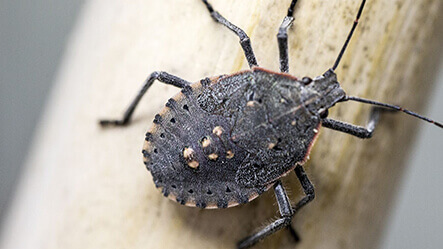Stink Bug Facts & Information
Everything you need to know about stink bugs
WHAT DO stink bugs LOOK LIKE

Stink bugs are described in several different ways. They are characterized as both “large, oval-shaped insects” and “shield-shaped insects.” Adult stink bugs can reach almost 2 cm in length. They are nearly as wide as they are long. Their legs extend from the sides, so this makes the adult bugs appear even larger. The brown marmorated stink bug is a brownish stink bug. It has lighter bands on the antennae and darker bands on the wings.
Adult stink bugs are good fliers and fold their wings on top of their body when they land. Nymphs do not have fully developed wings. The wings appear when the nymph becomes an adult. Fully developed wings are a way to identify adult stink bugs. Immature stink bugs, called nymphs, are very tiny when they hatch from their eggs. Nymphs of the brown marmorated stink bug are yellow and red. As they grow, the yellow fades to white. They have bright red eyes during the nymph stage of their life cycle. The nymphs molt or shed their skin five times. Each time a stink bug nymph molts, it becomes larger. By the last molt, the nymphs are almost as large as adult stink bugs.
Brown marmorated stink bugs mate and create up to 3 generations per year depending on their habitat. Cooler zones see one generation per year, while warmer areas are likely to see 2-3. Female stink bugs typically lay 20 to 30 eggs. Egg laying generally occurs from May through August. The eggs are light green, barrel-shaped, and are attached side-by-side on the underside of the host plant’s leaves in a mass. Eggs hatch four to five days later and the nymphs will begin to feed.
Stink bugs get their name from the unpleasant odor they produce when they’re threatened. It is thought that this odor helps protect the bugs against predators. The stink bugs produce the smelly chemical in a gland on their abdomen. Some species can actually spray the chemical several inches. The smell has often been compared to strong herbs and spices like cilantro and coriander.
Interestingly, the composition of the odor is comprised of chemicals commonly used as food additives and is present in cilantro. This smell can linger for hours so, if possible, try to avoid stink bugs or carefully sweep or vacuum them up if they’ve entered your house. And don’t be tempted to add them to your guacamole.
Adult stink bugs are good fliers and fold their wings on top of their body when they land. Nymphs do not have fully developed wings. The wings appear when the nymph becomes an adult. Fully developed wings are a way to identify adult stink bugs. Immature stink bugs, called nymphs, are very tiny when they hatch from their eggs. Nymphs of the brown marmorated stink bug are yellow and red. As they grow, the yellow fades to white. They have bright red eyes during the nymph stage of their life cycle. The nymphs molt or shed their skin five times. Each time a stink bug nymph molts, it becomes larger. By the last molt, the nymphs are almost as large as adult stink bugs.
Brown marmorated stink bugs mate and create up to 3 generations per year depending on their habitat. Cooler zones see one generation per year, while warmer areas are likely to see 2-3. Female stink bugs typically lay 20 to 30 eggs. Egg laying generally occurs from May through August. The eggs are light green, barrel-shaped, and are attached side-by-side on the underside of the host plant’s leaves in a mass. Eggs hatch four to five days later and the nymphs will begin to feed.
Stink bugs get their name from the unpleasant odor they produce when they’re threatened. It is thought that this odor helps protect the bugs against predators. The stink bugs produce the smelly chemical in a gland on their abdomen. Some species can actually spray the chemical several inches. The smell has often been compared to strong herbs and spices like cilantro and coriander.
Interestingly, the composition of the odor is comprised of chemicals commonly used as food additives and is present in cilantro. This smell can linger for hours so, if possible, try to avoid stink bugs or carefully sweep or vacuum them up if they’ve entered your house. And don’t be tempted to add them to your guacamole.
Where Do Stink Bugs Live
In general, adult stink bugs feed on fruits and nymphs feed on leaves, stems, and fruit. The life cycle of the brown marmorated stink bug generally involves mating, reproducing, and feeding from spring to late fall. Upon the onset of cold weather, stink bugs seek shelter to spend the winter in a dormant phase known as diapause.
Stink bugs search for overwintering sites in late fall before the weather conditions drastically change, leading them to seek out shelter in homes and other man-made buildings. They spend the winter hiding inside homes or businesses in Massachusetts, Connecticut, New York, Maine, Vermont, New Hampshire, and Rhode Island, usually in the walls, attic, or crawl space. However, entering into diapause may not be the complete end to their season of activity. If the weather warms up for a long enough period of time, indoor overwintering stink bugs might be misled into thinking it’s time to exit their diapause period and become active again. Stink bugs reemerge in early spring and become active. During warmer months, these pests can usually be found congregating on the sides of buildings.
Stink bugs search for overwintering sites in late fall before the weather conditions drastically change, leading them to seek out shelter in homes and other man-made buildings. They spend the winter hiding inside homes or businesses in Massachusetts, Connecticut, New York, Maine, Vermont, New Hampshire, and Rhode Island, usually in the walls, attic, or crawl space. However, entering into diapause may not be the complete end to their season of activity. If the weather warms up for a long enough period of time, indoor overwintering stink bugs might be misled into thinking it’s time to exit their diapause period and become active again. Stink bugs reemerge in early spring and become active. During warmer months, these pests can usually be found congregating on the sides of buildings.
How Did I Get Stink Bugs
Native to Asia, stink bugs were accidentally introduced into the United States sometime during the late 1990s. As an invasive species, they don’t have any natural predators and can therefore rapidly spread. Stink bugs have become established in many areas of the country, posing a particular threat to the agricultural industry as they destroy crops. Since they’re usually inside looking for a place to wait out the colder months, it’s nothing you’re doing that’s attracting them other than having warmth and shelter. They can easily slip in through a crack or crevice or a screen that hasn’t been replaced. They can even sneak in on deliveries!
What Problems Do Stink Bugs Cause
Stink bugs can damage ornamental plants, fruit trees, and gardens, but they are more of a nuisance than a threat to people. They do not cause structural damage or spread disease. The brown marmorated stink bug cannot sting and is not likely to bite, but care should be exercised when handling them to deter these pests from releasing their well-known and unpleasant odor. The stink bug’s mouthparts are grouped in the piercing/sucking category, but they do not use blood as a food source like mosquitoes, biting flies, and bed bugs. Their mouths are not structured in a way that enables them to bite through human skin. Most species of stink bugs feed on plants. They suck the juice from the leaves, stems, and roots of plants. They attack everything from ornamental plants to weeds. The insects pierce the skin of the plant and extract the juice inside.
How Can I Prevent Stink Bugs
To prevent stink bugs from entering homes and buildings, seal cracks around windows, doors, siding, utility pipes, behind chimneys, and underneath the wood fascia and other openings. Typical entry points include around door and window frames, electrical outlets, light switches, ceiling fans, skylights, and ceiling light fixtures. Having professional exclusion work done is best here since the technician will know what to use and where to use it. Damaged screens on doors and windows should be repaired or replaced. Stink bugs are attracted to light, so change exterior lighting to less-attractive yellow bulbs or sodium vapor lights.
If you need to know how to get rid of stink bugs that have already entered your home or business, a vacuum cleaner can aid in the removal of live or dead stink bugs. The bag must be discarded to prevent odor from permeating the area and so that the live ones don’t crawl out and right back into your home or business. After stink bugs have entered the structure, it is best to isolate the affected room or rooms by sealing the bugs out. If an infestation has developed inside the home or building, a professional stink bug exterminator should be called in.
If you need to know how to get rid of stink bugs that have already entered your home or business, a vacuum cleaner can aid in the removal of live or dead stink bugs. The bag must be discarded to prevent odor from permeating the area and so that the live ones don’t crawl out and right back into your home or business. After stink bugs have entered the structure, it is best to isolate the affected room or rooms by sealing the bugs out. If an infestation has developed inside the home or building, a professional stink bug exterminator should be called in.
Why Waltham for Stink Bug Control
We’re passionate about keeping stink bugs out of your home or business because we live and work here – it’s our neighborhood, too. With our almost 100 years of experience keeping homes and businesses in Massachusetts, Connecticut, New York, Maine, Vermont, New Hampshire, and Rhode Island safe from pests, Waltham has the experience you can trust.
Satisfaction Guarantee
24-Hour Guaranteed Response
Board Certified Entomologists
Consider stink bugs controlled.
GET MY QUOTE
“Exceptional service. Prompt and professional. Used for both business and home. Very efficient and honest.”
Agawan, MA
